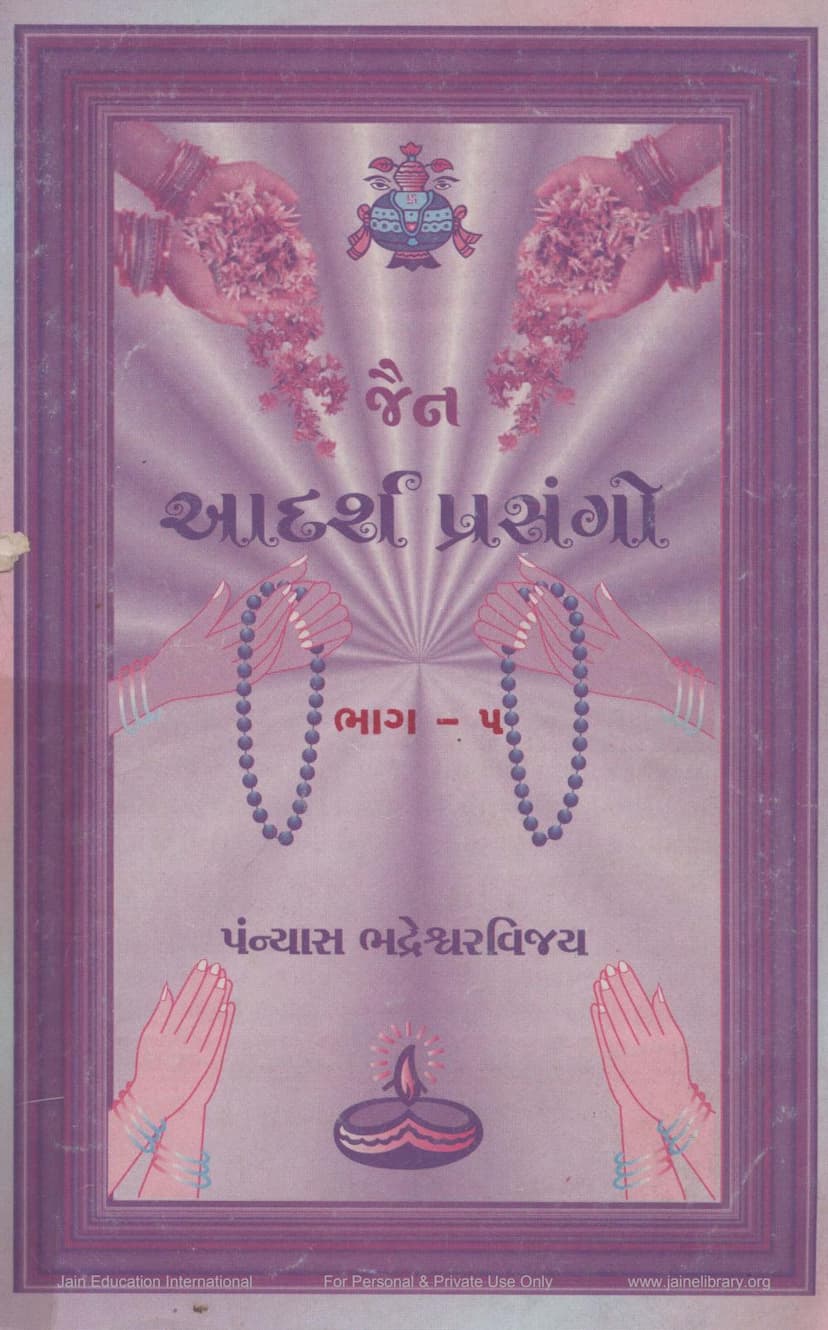Jain Adarsh Prasango Part 05
Added to library: September 1, 2025

Summary
Here's a comprehensive summary of "Jain Adarsh Prasango Part 05" by Bhadreshvarvijay, based on the provided text:
The book "Jain Adarsh Prasango Part 05" is a collection of inspiring anecdotes that highlight the principles and practices of Jainism. The author, Bhadreshvarvijay, aims to guide readers towards spiritual upliftment and righteous living through these real-life examples. The book is part of a series, with this volume focusing on specific exemplary incidents.
The core message of the book is to encourage readers to adopt Jain principles in their daily lives, emphasizing the power of devotion, good deeds, and adherence to religious tenets. Each anecdote serves as a testament to the efficacy of Jain practices in leading a fulfilling and spiritually rewarding life, both in this world and for future lives.
Here's a breakdown of the key themes and stories presented in the book:
-
The Significance of Guru Vandana (Salutations to the Guru): The first anecdote emphasizes the importance of showing respect and reverence to Jain monks and nuns. It illustrates how devotion and respect shown to spiritual guides can lead to spiritual liberation and the shedding of negative karma. The text encourages regular salutations to all monks and nuns, even unfamiliar ones, likening it to the importance of Jin Pooja (worship of deities).
-
The Transformative Power of Religious Discourses (Vyakhyan): The second story highlights how listening to religious lectures can deeply impact individuals, leading them to abandon worldly pursuits and dedicate their lives to spiritual practices. The example of Dilipbhai, who left a successful career in London to live a life of devotion and charitable work in India after being inspired by a lecture, underscores this point.
-
The Lasting Impact of Dharma (Righteousness) in Future Lives: The third narrative focuses on how consistent adherence to religious practices and a strong belief in Dharma can create positive impressions (sanskaras) that carry over into future lives. It illustrates how even in challenging times, individuals with strong past life impressions can naturally gravitate towards religious learning and practice, potentially leading to renunciation (diksha).
-
Parental Support for Spiritual Paths: The fourth anecdote addresses the crucial role of parents in supporting their children's spiritual aspirations, particularly the desire for renunciation. It contrasts the regret of parents who hinder their children's spiritual journey with the immense benefits reaped by those who encourage such paths. The story warns against the karmic repercussions of obstructing a child's spiritual inclination.
-
Devotion to Sadharmik (Fellow Jains): The fifth story celebrates the spirit of selfless service and support for fellow Jains. It recounts the example of a shop owner who made accommodations for his employee observing strict Jain practices, demonstrating the virtue of supporting those who adhere to religious vows. The anecdote also highlights the principle of karan, karavan, anumodan (doing, causing to do, and approving) and how supporting others' religious acts earns merit.
-
The Unfathomable Influence of Prabhu Darshan (Seeing the Lord): The sixth and seventh stories emphasize the immense power of devotion to Jain Tirthankaras (especially Lord Parshvanath) and the sacred Navkar Mantra. The story of the blind man who yearned to see Lord Parshvanath, even when physically unable to, and was miraculously granted a vision, illustrates the profound impact of unwavering faith. Similarly, the story of the young girl saved by chanting the Navkar Mantra showcases its protective and miraculous qualities.
-
The Efficacy of Guru Charanamrut (Water touched by the Guru's feet): The eighth anecdote showcases the miraculous healing power attributed to the sacred water that has come into contact with a Jain monk or nun. The immediate relief experienced by Sadhviji Sheetavardhanashriji from a severe respiratory ailment after consuming it highlights the reverence and faith placed in such sacred substances.
-
Divine Manifestations and Devotion: The ninth story recounts an extraordinary experience where celestial beings were seen performing puja for the main deity in a temple. This incident, witnessed by a devout devotee, serves as a powerful testament to the fact that even gods are drawn to and participate in the worship of Tirthankaras, reinforcing the sanctity of Jain worship.
-
Emulating Good Deeds and the Power of Samayik (Meditation): The tenth anecdote inspires readers to cultivate the habit of emulating virtuous actions. It highlights how observing the consistent practice of samayik (a period of Jain meditation) by influential individuals can motivate others to adopt similar spiritual disciplines, leading to personal growth and a more virtuous life.
-
The Virtue of Losch (Offering alms to monks/nuns) and Tithi Paushadh (Observing vows on specific auspicious days): The eleventh and twelfth stories praise the dedication of devotees who selflessly offer losch (alms) to Jain monks and nuns, highlighting the immense merit earned through such acts. The practice of Tithi Paushadh is also encouraged as a means of spiritual purification and earning merit.
-
Abstinence from Ratribhojan (Night-eating): The thirteenth anecdote underscores the seriousness with which some Jains approach the prohibition of eating after sunset. The example of a devotee who even abstains from drinking water at the homes of those who observe night-eating illustrates the extreme dedication and the strong belief in avoiding even indirect association with this practice.
In conclusion, "Jain Adarsh Prasango Part 05" is a compilation of stories designed to inspire readers to deepen their faith and practice of Jainism. It emphasizes that by following the teachings of the Tirthankaras and the guidance of spiritual leaders, individuals can achieve spiritual liberation, earn merit, and lead lives filled with peace and happiness. The book encourages readers to reflect on these examples, incorporate them into their lives, and share these inspiring narratives with others to propagate the message of Dharma.